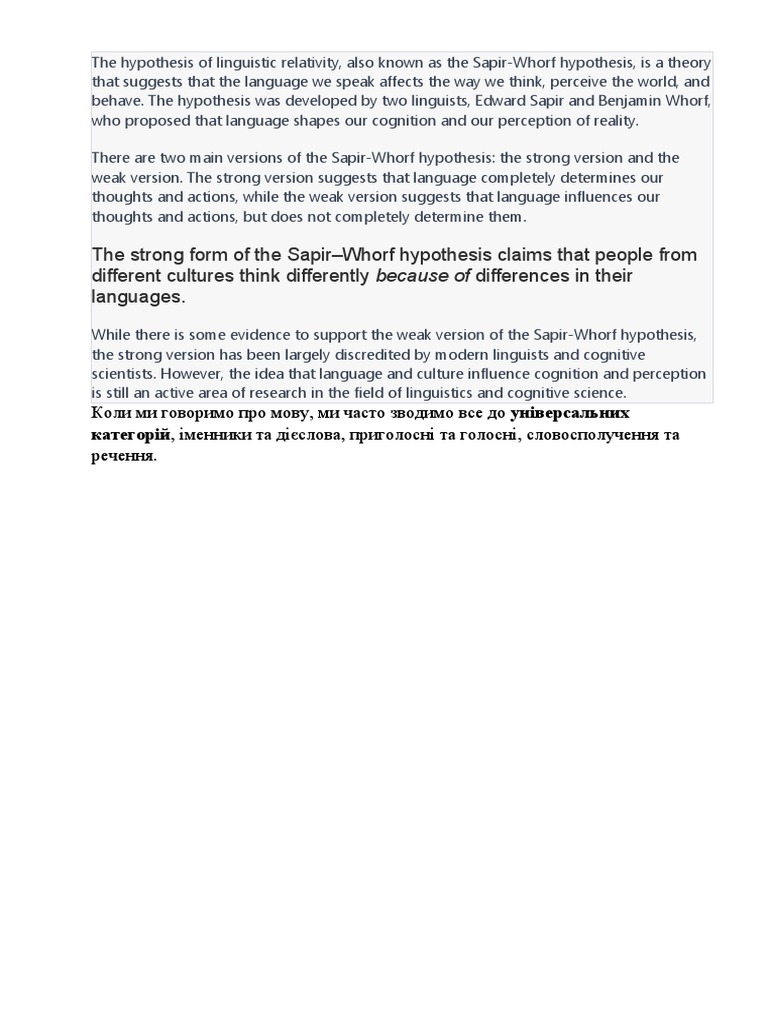The Sapir-Whorf Hypothesis, which posits that the structure of a language influences its speakers’ worldview, serves as a fascinating lens through which we can examine the Polish language. This hypothesis, also known as linguistic relativity, suggests that not only does language serve as a vehicle for communication, but it also molds our perceptions and cognitive processes. Within the intricate landscape of Polish, one can discern how specific linguistic elements reveal unique cultural aspects and worldviews.
To delve into this metaphorical richness, consider the Polish language as a tapestry woven from historical threads. This language, with its complex grammar and vocabulary, embodies the collective consciousness of its speakers. Each word and grammatical structure encapsulates distinct cultural values and societal norms, mirroring the community’s way of life. For example, the use of diminutives is prevalent in Polish and signifies tenderness or affection. This grammatical feature mirrors the Polish emphasis on familial bonds and close relationships, showcasing how linguistic nuances reflect cultural priorities.
Furthermore, the nuances of the Polish language also expose its relationship with nature—a noteworthy concept in the context of the environmental discourse. The vocabulary surrounding the natural world in Polish is often rich and varied. Words for different trees, rivers, and seasonal changes not only enrich the language but also indicate a profound connection to the environment. This linguistic relationship exemplifies how the Polish worldview cherishes its surroundings, imploring speakers to engage with and respect the natural world.
Every language shapes thought. The Polish language, in its multi-faceted glory, offers a multitude of ways to express complex emotions and ideas. The distinctions between formal and informal speech reveal a societal structure that values politeness and respect, thereby encouraging more mindful interactions. This reflects an ingrained cultural respect for social hierarchy and relationships, fostering a community-oriented mindset. Additionally, the use of various verb aspects in Polish can reshape narratives about action and time, empowering speakers to frame their experiences in multifaceted dimensions. A simple action can shift in tone and implication depending on how it is articulated, revealing the Polish way of preserving history and memory through language.
Moreover, Polish verbs are categorized into perfective and imperfective aspects, which convey nuanced temporal perspectives. This differentiation encourages speakers to reflect on their actions’ completeness and ongoing nature, fostering a deeper connection to the continuity of life experiences. This linguistic feature encourages a thoughtful approach to life, promoting careful consideration of actions and their long-term implications, both personally and environmentally. In a world facing climate change, such linguistic reflections could guide collective action toward sustainability.
Linguists have also noted how the structure of the Polish language may shape the perception of time. Polish utilizes a somewhat cyclical understanding of time, where events are interconnected rather than delineated as a linear progression. This cyclical perception mirrors natural processes, aligning with the environmental ethos of ecosystems where everything is interdependent. Emphasizing interconnectedness cultivates an awareness that actions today echo into the future, reinforcing the importance of sustainability in Polish culture.
Furthermore, the rich folklore and idiomatic expressions within Polish can reveal environmental attitudes and historical relationships with nature. Phrases that incorporate natural elements enrich the language and reflect a culture steeped in agricultural traditions and respect for the earth. Phrases like “rzecz jasna” (literally “a clear thing,” used to mean “of course”) wonderfully illustrate how elements from nature infuse everyday language, grounding it in local landscapes and experiences. Such expressions evoke a sense of place, linking language to identity and belonging, further entwining linguistic and environmental threads.
The interaction between the Polish language and its speakers extends beyond mere vocabulary. It is a dance of culture, history, and ethics. The language captures the essence of a community’s relationship with nature, weaving a narrative that resonates powerfully in an era where environmental consciousness is paramount. For those engaged in climate activism, understanding these linguistic subtleties becomes crucial. They offer insights into how language can inspire action and foster a profound respect for the environment. By acknowledging the impact of language on perceptions and behaviors, effective communication strategies can be developed in the pursuit of ecological advocacy.
In conclusion, the Sapir-Whorf Hypothesis provides a compelling framework for examining the Polish language. By understanding how linguistic structures and vocabulary reflect cultural values, one can appreciate the profound connections between language and environmental awareness. The Polish language, with its intricate grammar and evocative expressions, not only conveys meaning but shapes the way its speakers perceive the world. As we navigate an era punctuated by climate crisis, the insights garnered from this exploration may empower individuals and communities in their quest for a sustainable future. The Polish language is not merely communication; it is a vital cultural artifact that embodies the wisdom of historical relationships with nature, urging speakers towards mindful stewardship of the planet.
